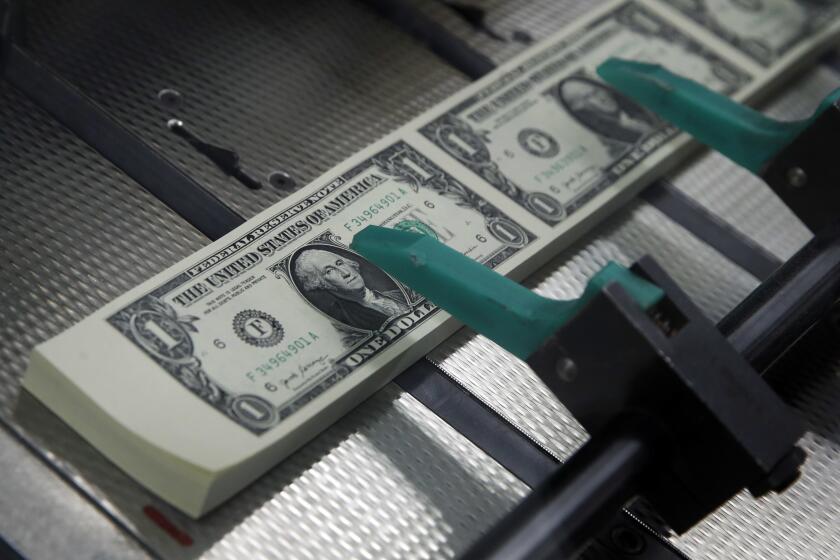U.S. debt woes are not so dire, experts say
WASHINGTON — Listening to the political shouting match and seeing Washington lurch from one fiscal crisis to another, one might think the federal budget deficit is the economic equivalent of a giant meteor hurtling toward America, about to hit any day.
The reality is quite different. In fact, the debt is probably not even the country’s biggest economic challenge, most experts say, and certainly not the most urgent.
The evidence shows that the country is on a course of spending and debt accumulation that could lead to serious trouble not today or tomorrow but probably 10 to 20 years down the road.
What the evidence does not show is that such a crisis is close at hand or that the U.S. is in any imminent danger of turning into an economic basket case like present-day Greece.
Moreover, financial experts agree that although America’s burgeoning healthcare costs pose huge long-term challenges for the budget, the nation’s debt could most likely be controlled for at least the next decade by making a series of relatively moderate policy changes. Those changes, although perhaps unwelcome, would not require drastic adjustments in the lives of most Americans.
Yet the bitterly partisan argument over the deficit and the national debt will surely burst forth again in coming weeks.
Congress barely avoided the full “fiscal cliff” of spending cuts and tax hikes at year’s end, and Republican lawmakers last week merely delayed until this summer another showdown with the White House over the debt ceiling.
The next budget flash points are even closer: Mandatory spending cuts, the so-called sequester, are set to take effect March 1, followed by the March 27 deadline when spending authority must be renewed or the government could be shut down.
“Fiscal policy is a mess,” said analysts at Macroeconomic Advisers, a major forecasting firm. “The debt ceiling, the sequester and the expiring budget resolution comprise a three-pack of uncertainties that in the near term is bad for the economy.”
Yet separate the economic wheat from the political chaff, and the solution is not that hard.
Over the last two years, policymakers have enacted measures cutting almost $2.4 trillion from projected deficits over the next decade. Most of that deficit reduction came from reductions in federal programs approved as part of the debt-ceiling deal in 2011. About $650 billion of the total comes from new revenue generated by tax increases on the wealthy that were part of this month’s fiscal-cliff deal.
Taken together, economists and budget experts reckon, an additional $1 trillion to $1.4 trillion in savings would be enough to stabilize the national debt as a share of the overall economy. That would be achieved by bringing the deficit down to 2.5% of the country’s annual gross domestic product, about one-third the share last year.
“That’s manageable; we’ve done a big chunk already,” said Roberton Williams, a senior fellow at the nonpartisan Tax Policy Center. “You can do that by raising taxes a little bit more or by cutting spending.... That’s something that’s doable.”
Moody’s Analytics economist Mark Zandi, who regularly advises Democratic and Republican lawmakers, agreed.
Even if the bulk of the additional deficit savings needed came from reduced spending as opposed to higher taxes, he said, those cuts could be done by “tweaking programs,” such as changing the inflation index for Social Security, aligning Medicare drug payments with Medicaid and reducing some farm subsidies.
“It wouldn’t be a wrenching restructuring,” he said.
So why the frequent paroxysms in Washington over the debt and the eleventh-hour deals to avert seeming disaster?
In large part, the fight over deficits and spending has become a surrogate for battles over basic political and ideological disagreements over the role of government and, behind the scenes, over how the economic pie should be divided. There also are some real differences in how people view the debt and the risks to the economy.
If the country could get $1.4 trillion more in deficit savings, total public debt would stabilize at the current level of about 73% of GDP within a few years, according to Richard Kogan, a senior fellow at the Center on Budget and Policy Priorities, a Washington research group. That’s still high by historical standards, and economists worry that such large public debts are corrosive to growth and give the economy little cushion should another recession strike or interest rates surge.
Still, even with the level of debt as high as it has been recently, the U.S. has not had any trouble borrowing money from abroad at very low rates. The nation’s debt as a share of GDP remains lower than in such countries as Japan, Germany and Canada.
And despite high unemployment, stagnant wages, widening social and economic gaps and other significant challenges, the country’s economy is growing, its core inflation remains in check, its credit standing is still strong and it has control over its currency, unlike Eurozone nations.
For all the political dysfunction and brinkmanship in Washington, with each averted crisis, investors seem to be taking things in stride.
“The ongoing assumption is that somehow, some way, some compromise will be reached, and we continue to see evidence of that,” said Paul Zemsky, head of multi-asset investments at ING Investment Management.
As the economy shows signs of improvement, he said, Washington’s deficit situation is not so daunting. “When you look at the next 10 years, it’s not that bad.”
The problem gets more daunting after that. Even if the debt is stabilized as Kogan described, it would begin to rise after 2023, first very slowly and then with increasing speed in later years unless significant changes can be made in the rate of healthcare inflation.
Assuming no other major changes in the economy or government programs, Zandi says, his models show a similar trend, with a fiscal meltdown hitting in 2028.
Two factors would drive that increase. The smaller one is that the aging of the huge baby boomer generation has started to pinch Social Security’s finances, as has been forecast for years. The system paid more than it took in in 2010 and 2011, the first time that has happened since 1983.
“Social Security has always added to government net resources; now it’s running deficits of $100 billion or more a year,” said J.D. Foster, a senior fellow at the Heritage Foundation.
Although by law Social Security does not directly add to the nation’s debt, the system’s changing financial picture creates potential problems. When Social Security taps some of its vast surplus from previous years to keep from cutting benefits, the government has to borrow to produce that money because it already has used it.
Still, spending on Social Security will rise only to 6% of GDP in 2030, from 5% today, according to the Congressional Budget Office. And the trust fund isn’t projected to run out of money until 2033.
Federal expenditures for healthcare are projected to rise much faster and are the single biggest problem for the long-term sustainability of the budget.
Spending for Medicare, the largest of the government’s health programs, grew an average of 6.7% a year from 2007 through 2011. It rose by only half that in the last fiscal year, but experts say it’s hard to know whether that slowdown is permanent.
“By later in the decade, we should have substantially more knowledge of what works and what doesn’t” to slow healthcare cost without impairing quality, Kogan said in a recent policy paper.
Stabilizing the debt over the coming decade, he said, would “buy time to find answers to these important questions.”
More to Read
Inside the business of entertainment
The Wide Shot brings you news, analysis and insights on everything from streaming wars to production — and what it all means for the future.
You may occasionally receive promotional content from the Los Angeles Times.












